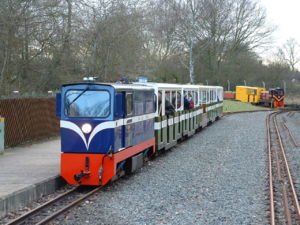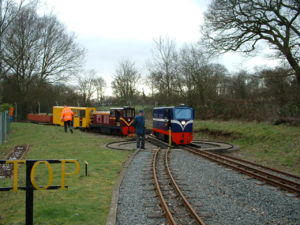Ruislip Lido Railway
The Ruislip Lido Railway is a 12-inch (305-mm) gauge miniature railway, running around the popular tourist attraction of 'Ruislip Lido' in Ruislip, Greater London, just 14 miles (22.5 km) from the centre of London. The railway runs from the main station at Woody Bay by the lido's beach, round a 1.5-mile (2.4-km) track around the lake, through the Ruislip woods to 'Water's Edge Station' by the lido's car park. The line runs through 2 disused stations (formally termini stations), these being 'Eleanor’s Loop' and 'Haste Hill'. The section of track between Woody Bay and Wellington Junction is double track, with passing loops at Eleanor’s Loop and Haste Hill. These loops allow two-train operation on certain days of the year to take place. There is also a level crossing between Haste Hill and Water's Edge station (also known as Ruislip Lido Station).
The railway has recently been quoted by HM Rail Inspectorate as "probably the best run, well maintained narrow gauge railway in Britain, with an extremely smooth ride."
The railway has 6 locomotives - 5 diesels and 1 steam:
ROBERT (No.3) - The oldest is 'Robert', which is a 4-4w diesel-hydraulic locomotive built in 1973 by Severn Lamb Ltd. 'Robert' is now grounded and is not allowed out of the sheds. The reason is because the flanges on the wheels are so worn down, that the insurance company won’t insure it. There are now plans to now sell this locomotive.
LADY OF THE LAKES (No.5) - 'Lady Of The Lakes' is a 4w-4w diesel-mechanical locomotive built in 1986 by the Ravenglass and Eskdale Railway. She is still in use today as one of the most reliable locos on the line, despite the fact she has an engine over 40 years old. Until recently, she saw regular use on the PW train, but is now being used on the passenger service. Plans exist to send her away for a rebuild.
GRAHAM ALEXANDER (No.7) - The next locomotive is 'Graham Alexander', 4w-4w diesel-mechanical loco with an engine and gearbox design based on ‘Lady Of The Lakes’. Severn Lamb built ‘Graham Alexander’ in 1990. The driving controls are identical to Lady; however, the exteriors differ immensely, and not just the different colours. ‘Graham Alexander’ was sent to Severn Lamb UK Ltd at the start of 2006 to be rebuilt. It is now back in regular service.
BAYHURST (No.8) and JOHN RENNIE (No.9) - The two newest additions to the line are 'Bayhurst' and 'John Rennie', built in 2003 and 2004 by Severn Lamb. They are both 4w-4w diesel-hydraulic engines. Both engines are almost identical internally and the body shape is the same. The only difference between the two is that 'Bayhurst' is green with a white stripe, and 'John Rennie' is red with a yellow stripe.
MAD BESS (No.6) - 'Mad Bess', a 2-4-0 Saddle Tank Tender built at the lido by the society in 1998. She is oil-fired owing to the risk of fire from the woods and she is based on older sister 'Blanche' of the Ffestiniog Railway in Wales.
Radio control is the way in which trains are moved around the circuit and this practice is conducted in a highly professional manner. The railway also has its own team of permanent way staff who maintain the track to a high standard.
The railway is run entirely by volunteers with many young rail enthusiasts involved within the railways operations.
In the early hours of 17th July 2006, one of sheds was broken into, and the PW riding van (506) was taken up the line and torched. The first train the following morning, got to Haste Hill loop to find the remains sitting over the double set of points. The police were called and fingerprints/DNA samples were recovered. Upgraded security measures such as CCTV will probably be installed. As a result, this item of rolling stock is now a write off and a new one will need to be built. The two photos that accompany this article show 506 (the yellow coach) before the attack. It is now a shell, but will probably be converted into a flatbed wagon. A couple of line side signs were damaged. It must be said though that the railway is very well secured, a safe and well run line, and this is the first incident like this in over 60 years.
External links
- Aerial photo of Ruislip Lido Railway. Other map and aerial photo sources.
- Official Website of Ruislip Lido Railway


